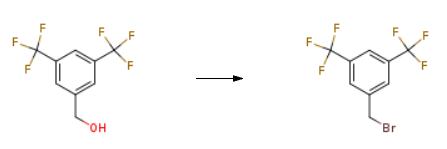| Identification | More | [Name]
3,5-Bis(trifluoromethyl)benzyl bromide | [CAS]
32247-96-4 | [Synonyms]
1-(BROMOMETHYL)-3,5-BIS(TRIFLUOROMETHYL)BENZENE
1-(BROMOMETHYL)-3,5-DI(TRIFLUOROMETHYL)BENZENE
3,5-BIS(TRIFLUOROMETHYL)BENZYL BROMIDE
3,5-DI(TRIFLUORO METHYL)BENZYL BROMIDE
3,5-Di(Trifluoro Methyl)Benzyl Bromide 3,5-bis(Trifluoromethyl)benzyl Bromide
3,5-Bis(trifluoromethyl)benzyl bromide 98%
3,5-Bis(trifluoromethyl)benzylbromide98%
3,5-Bis(trifluoromethyl)benzyl bromide, 97+%
1,3-Bis(trifluoromethyl)-5-(bromomethyl)benzene
3,5-Bis(trifluoromethyl)benzylbromiode | [EINECS(EC#)]
250-971-1 | [Molecular Formula]
C9H5BrF6 | [MDL Number]
MFCD00009905 | [Molecular Weight]
307.03 | [MOL File]
32247-96-4.mol |
| Safety Data | Back Directory | [Hazard Codes ]
C,F | [Risk Statements ]
R10:Flammable.
R34:Causes burns. | [Safety Statements ]
S26:In case of contact with eyes, rinse immediately with plenty of water and seek medical advice .
S36/37/39:Wear suitable protective clothing, gloves and eye/face protection .
S45:In case of accident or if you feel unwell, seek medical advice immediately (show label where possible) .
S25:Avoid contact with eyes .
S16:Keep away from sources of ignition-No smoking . | [RIDADR ]
UN 2920 8/PG 2
| [WGK Germany ]
3
| [Hazard Note ]
Corrosive/Lachrymatory | [HazardClass ]
8 | [PackingGroup ]
III | [HS Code ]
29039990 |
| Hazard Information | Back Directory | [Chemical Properties]
light yellow liquid | [Uses]
3,5-Bis(trifluoromethyl)benzyl bromide is used as derivatization reagent in detection of uracil in DNA by GC and negative chemical ionization mass spectrometry in enantioselective synthesis of non-peptidic neurokinin NK1 receptor antagonist. | [Synthesis]
Synthesis of 3, 5-bis (trifluoromethyl)-benzyl bromide:
In a 4-neck flask with capacity 1000 ml equipped with mechanical agitator, thermometer, bubble condenser and 100 ml loading funnel, 262.2 g of the product of Example 1 (ii) at 92. 8% (0. 988 moles), 550,2 g HBr 48% (3.2645 moles) are loaded; this is heated at 50°C so as to melt the alcohol, then one starts to dose 113 g of concentrated His04 (1.153 moles). Pouring is accomplished in 30 minutes, noting an increase of the internal temperature. This is heated to 100-105°C and left to react for 8 hours. The reaction is completed by reflux heating for per 1.5 hours. the mixture is left to settle and the phases are separated; the solvents are removed from the organic phase and the product in the title is obtained with a yield of 99.1 %.

|
|
|